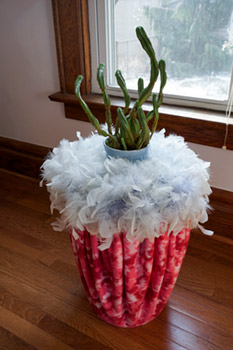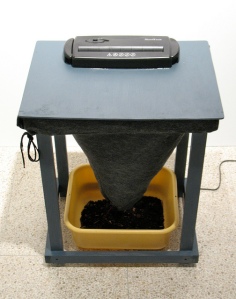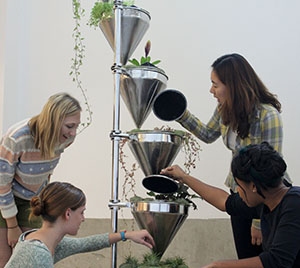Homes for Worms – Red wigglers, or Eisenia Fetida, are ideally suited to a domestic situation. They thrive in the same temperature ranges as humans and eat many of the same foods. When provided with a dark, moist enclosure, they remain unseen, unheard and undetected by smell, as they process waste generated by a typical home into nutrients that can be used to feed plants. They can eat half of their weight of food per day and, since they eat food and paper waste, they comprise one of the most efficient home waste processing systems known. They do not smell. In fact, one of the things worms eat are the offensive, smell-emitting microorganisms that grow on decomposing organic waste. They help us reduce greenhouse gas emissions by eating food waste that would otherwise create methane when decomposing in landfills.
There are many basic homes for worms that you can build yourself. Personally, I wanted a flow-through system for easier separation of worms from finished compost. Most are industrial, but I wanted a small home version, so I designed and created instructions for this Worm Bin Bag, made of cheap, recycled polyester felt attached to a wood frame. If you don’t want to build it yourself someone (not me) is selling a nice-looking version of it, called the Worm Inn. Another related product is the worm bag that is integrated into the Cascading Garden Growbags made by Ken Rinaldo.

Basic plastic tote worm bin. Photo by Kid Missile
The most basic worm home is the plastic tote, which can be as simple as a plastic bin (one that does not let much light into it) with a lot of holes drilled into it and a tray to catch any excess moisture. Your worms will be happy, and this might be all you need to be happy too.

from RedWormComposting.com
Or you can make one that is more functional and easy to use, like this double stacked version described by Bentley Christie on RedWormComposting.com. He has made a nice how-to video of this double stacked version. Bentley has also created guides for building and caring for a variety of plastic tote worm bins on his RedWormComposting.com site. This is also the best worm blog online, so do visit it for more info on getting started – and staying with it.
If you want to get adventurous, you can make your own vermiculture furniture, or a hydroponic worm and plant ecosystem, or a table to eat with worms. Or a Worm Cozy.
Or perhaps you will come up with your own customized worm home that we will feature here. Please send us your interesting worm homes via our contacts page, or tag them with #wormculture so we find them. Or, apply to the Vermi-Prize contest.
Looking for worms? Ask your friends. Many people who already have them are willing to share worms with others, since they are a renewable resource (their colonies reproduce to meet the size of their home and the amount of food fed). If you do not already have a worm-keeping friend, you might find one on the Vermicomposters Map. It is a great resource of worm people around the world. You can put yourself on the map and offer to share your worms with others. I often give away a bag of worms with to people in my area who contact me from the map. I don’t sell them, deliver, or ship them to people, and I don’t separate them from their bedding or partially eaten foodstuffs. If you want that, you might find a local, or nearby, worm seller on the map.





